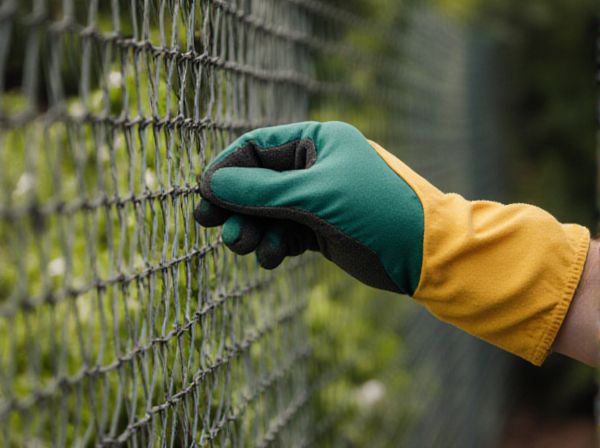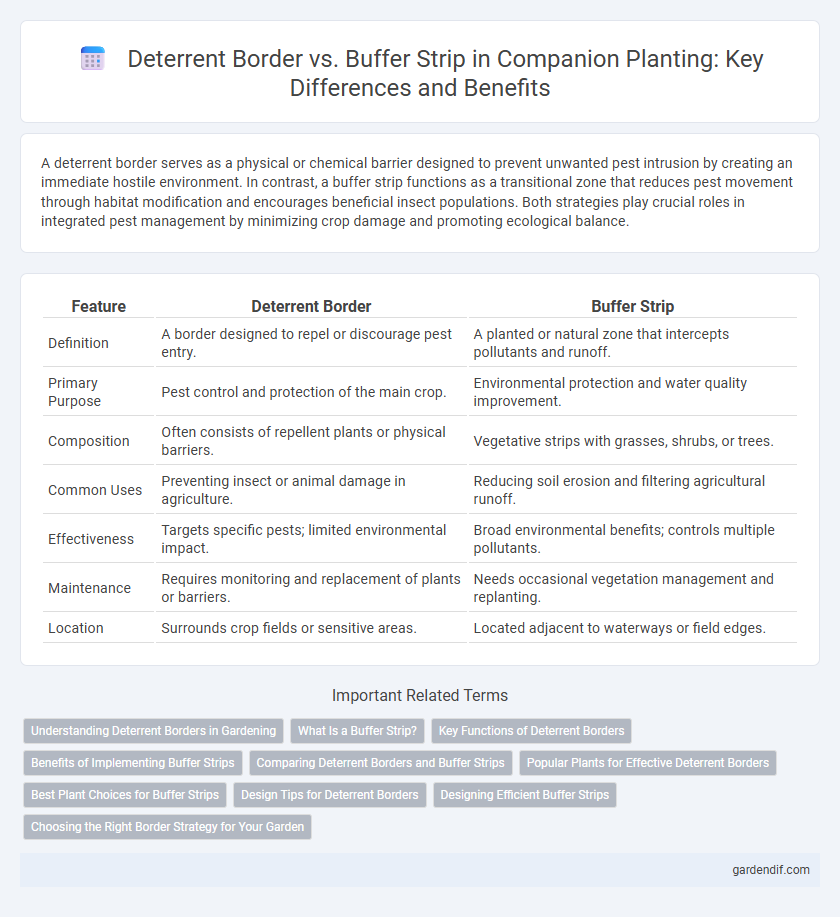
Deterrent border vs buffer strip Illustration
A deterrent border serves as a physical or chemical barrier designed to prevent unwanted pest intrusion by creating an immediate hostile environment. In contrast, a buffer strip functions as a transitional zone that reduces pest movement through habitat modification and encourages beneficial insect populations. Both strategies play crucial roles in integrated pest management by minimizing crop damage and promoting ecological balance.
Table of Comparison
| Feature | Deterrent Border | Buffer Strip |
|---|---|---|
| Definition | A border designed to repel or discourage pest entry. | A planted or natural zone that intercepts pollutants and runoff. |
| Primary Purpose | Pest control and protection of the main crop. | Environmental protection and water quality improvement. |
| Composition | Often consists of repellent plants or physical barriers. | Vegetative strips with grasses, shrubs, or trees. |
| Common Uses | Preventing insect or animal damage in agriculture. | Reducing soil erosion and filtering agricultural runoff. |
| Effectiveness | Targets specific pests; limited environmental impact. | Broad environmental benefits; controls multiple pollutants. |
| Maintenance | Requires monitoring and replacement of plants or barriers. | Needs occasional vegetation management and replanting. |
| Location | Surrounds crop fields or sensitive areas. | Located adjacent to waterways or field edges. |
Understanding Deterrent Borders in Gardening
Deterrent borders in gardening are strategically designed to prevent unwanted pests and animals from damaging plants by creating physical or sensory barriers. Unlike buffer strips, which primarily serve to separate different planting areas and minimize soil erosion or nutrient runoff, deterrent borders actively repel or block intruders using materials such as thorny plants, gravel, or reflective surfaces. Implementing an effective deterrent border enhances garden protection while maintaining aesthetic appeal and plant health.
What Is a Buffer Strip?
A buffer strip is a designated area of vegetation planted between agricultural fields and bodies of water to reduce runoff and prevent soil erosion. Unlike deterrent borders, which primarily serve as physical barriers to discourage trespassing or animal movement, buffer strips enhance environmental quality by filtering pollutants and improving water quality. Implementing buffer strips supports sustainable land management and conserves ecosystems adjacent to farmlands.
Key Functions of Deterrent Borders
Deterrent borders serve as physical or psychological barriers designed to prevent unauthorized access and enhance security along boundaries. Key functions include restricting movement, signaling territorial limits, and reducing potential conflicts by clearly demarcating zones. These borders often incorporate natural or artificial elements like fences, walls, or dense vegetation to create effective obstruction and promote surveillance.
Benefits of Implementing Buffer Strips
Buffer strips enhance soil stability by reducing erosion and improving water infiltration along borders, leading to better agricultural productivity. They create natural habitats for beneficial insects and wildlife, increasing biodiversity and aiding pest control. These vegetative barriers also filter runoff, preventing contaminants from entering water bodies and maintaining environmental quality.
Comparing Deterrent Borders and Buffer Strips
Deterrent borders use physical or chemical barriers to prevent weed encroachment and pest invasion along crop edges, providing targeted protection through active repellent measures. Buffer strips consist of vegetative zones planted between fields, serving as passive filters to reduce erosion, runoff, and habitat for beneficial organisms. Comparing deterrent borders and buffer strips highlights that deterrent borders actively reduce pest pressures, while buffer strips primarily enhance environmental quality and biodiversity.
Popular Plants for Effective Deterrent Borders
Effective deterrent borders often feature plants like lavender, rosemary, and marigolds, known for repelling pests naturally. These species emit strong scents or contain compounds that deter insects and animals, reducing damage to crops and gardens. Incorporating such plants in companion planting enhances biodiversity while serving as a sustainable pest control method.
Best Plant Choices for Buffer Strips
Buffer strips are most effective when planted with a mix of native grasses, wildflowers, and shrubs that stabilize soil and enhance biodiversity while filtering runoff. Species such as switchgrass (Panicum virgatum), black-eyed Susan (Rudbeckia hirta), and elderberry (Sambucus canadensis) thrive in buffer strips by providing strong root systems and habitat for beneficial insects. Selecting plants with deep roots improves water filtration and erosion control, making these species optimal for buffer strip implementation along waterways.
Design Tips for Deterrent Borders
Deterrent borders are designed to discourage pest entry by incorporating dense, thorny, or aromatic plants that create physical and sensory barriers. Strategic placement of companion plants with strong scents or textures such as lavender, marigolds, or rosemary enhances pest repellent effects while supporting beneficial insects. Maintaining a narrow width and avoiding excessive mulch can improve visibility and air circulation, further optimizing the deterrent border's effectiveness.
Designing Efficient Buffer Strips
Designing efficient buffer strips requires selecting vegetation that maximizes pollutant filtration, enhances wildlife habitat, and stabilizes soil to prevent erosion. Buffer strips serve as a sustainable alternative to deterrent borders by integrating multiple environmental functions while maintaining aesthetics and land usability. Strategic placement and varying width based on slope and runoff intensity optimize the ecological benefits of buffer strips.
Choosing the Right Border Strategy for Your Garden
Choosing between a deterrent border and a buffer strip depends on your garden's specific needs for pest control and plant protection. Deterrent borders use plants or materials that repel pests and prevent unwanted intrusion, enhancing garden security and reducing chemical usage. Buffer strips create a physical separation between garden zones, minimizing disease spread and protecting delicate plants from environmental stressors like wind and soil erosion.
Deterrent border vs buffer strip Infographic

 gardendif.com
gardendif.com